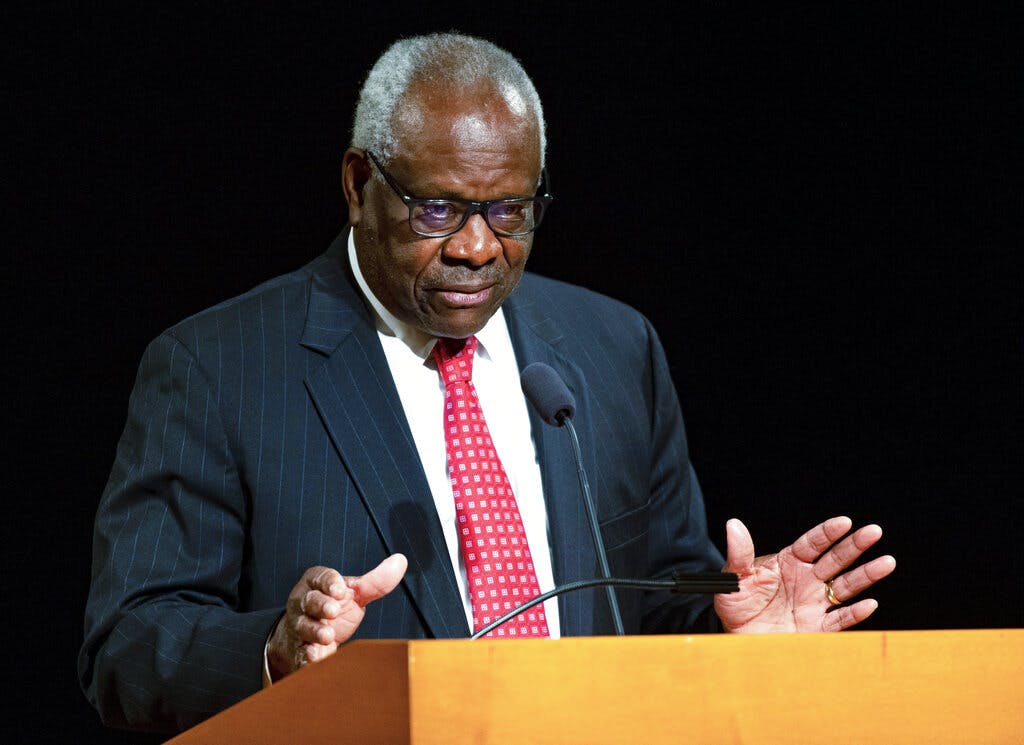Justice Thomas’s Hospitalization a Plangent Reminder of Court’s Balance
Justice Thomas’s replacement by a liberal justice would undo the conservative gains made when Justice Ginsburg gave way to Justice Coney Barrett.

With Justice Clarence Thomas in a hospital bed, the stakes surrounding the fight to appoint the next Supreme Court justice are coming into sharper focus.
Even as Judge Ketanji Brown Jackson gears up for her confirmation effort that begins today, it has been widely seen that if she were successful in replacing Justice Stephen Breyer, the move would merely hold the court’s ideological serve.
That would most emphatically not be the case should the prospect arise that Justice Thomas’s seat could unexpectedly come to be open during President Biden’s tenure in the White House.
The 9 announced Sunday that Justice Thomas has been hospitalized with an infection since Friday with “flu-like symptoms,” and that he would “participate in the consideration and discussion of any cases for which he is not present on the basis of the briefs, transcripts, and audio of the oral arguments.”
While Justice Thomas is widely expected to recover and be released from the hospital in “a day or two,” the 73-year-old jurist’s health scare is a plangent reminder that the next battle royale at the intersection of politics and jurisprudence could be just around the corner.
Justice Thomas has become the court’s conservative bulwark. While Chief Justice Roberts trims sails and endeavors to shape the court’s consensus, Justice Thomas builds an unassailable conservative record.
Justice Thomas’s replacement by a liberal justice would undo the conservative gains made when Justice Ruth Bader Ginsburg gave way to Justice Amy Coney Barrett, and could alter the high court’s trajectory for a generation.
While Justice Thomas has often been criticized for being taciturn on the bench — he famously did not ask a question in oral arguments for a decade — his written opinions have long been unafraid of iconoclasm.
Even as Justice Thomas’s wife, Ginni Thomas, has attracted criticism for her political entanglements, most recently by her acknowledgment that she attended the January 6 ‘Stop the Steal rally,’ the undaunted justice is now in his fourth decade of anchoring the court’s right-leaning flank with his brand of constitutional originalism.
In both the majority and as a dissenter, Justice Thomas has staked out important constitutional turf that would be untrod should a potential replacement be proffered under a Democratic president.
In Brown v. Entertainment Merchants Association, Justice Thomas penned a famous dissent to the majority’s opinion that a state ban on direct sale or rental of violent video games to minors was facially unconstitutional.
He wrote that “the practices and beliefs of the founding generation establish that ‘the freedom of speech,’ as originally understood, does not include a right to speak to minors (or a right of minors to access speech) without going through the minors’ parents or guardians.”
The upshot of this was that the Founders “believed parents to have complete authority over their minor children and expected parents to direct the development of those children.”
In another famous dissent, this time in Gonzalez v. Reich, Justice Thomas vehemently disagreed with his colleagues in his belief that the Constitution’s Commerce Clause could not bar the growing of marijuana for personal use.
If it could, he believed, “the Federal Government may now regulate quilting bees, clothes drives, and potluck suppers throughout the 50 States.”
Justice Thomas has not always been in dissent. In Good News Club v. Milford Central School, he wrote for the majority in determining that banning a religious student organization from meeting on school premises violated the First Amendment.
A hallmark of Justice Thomas’s judicial philosophy has been opposition to government countenanced affirmative action.
In Fisher v. Texas, which held that a university’s use of race in college admissions could survive under the Constitution’s Equal Protection Clause, Justice Thomas dissented and wrote that “a State’s use of race in higher education admissions decisions is categorically prohibited by the Equal Protection Clause.”
With the 9 set in the fall to hear Students for Fair Admissions v. Harvard, a case seeking to topple Fisher, a court without Justice Thomas would be far likelier to hew to the status quo of race-conscious admissions than to upend it.

